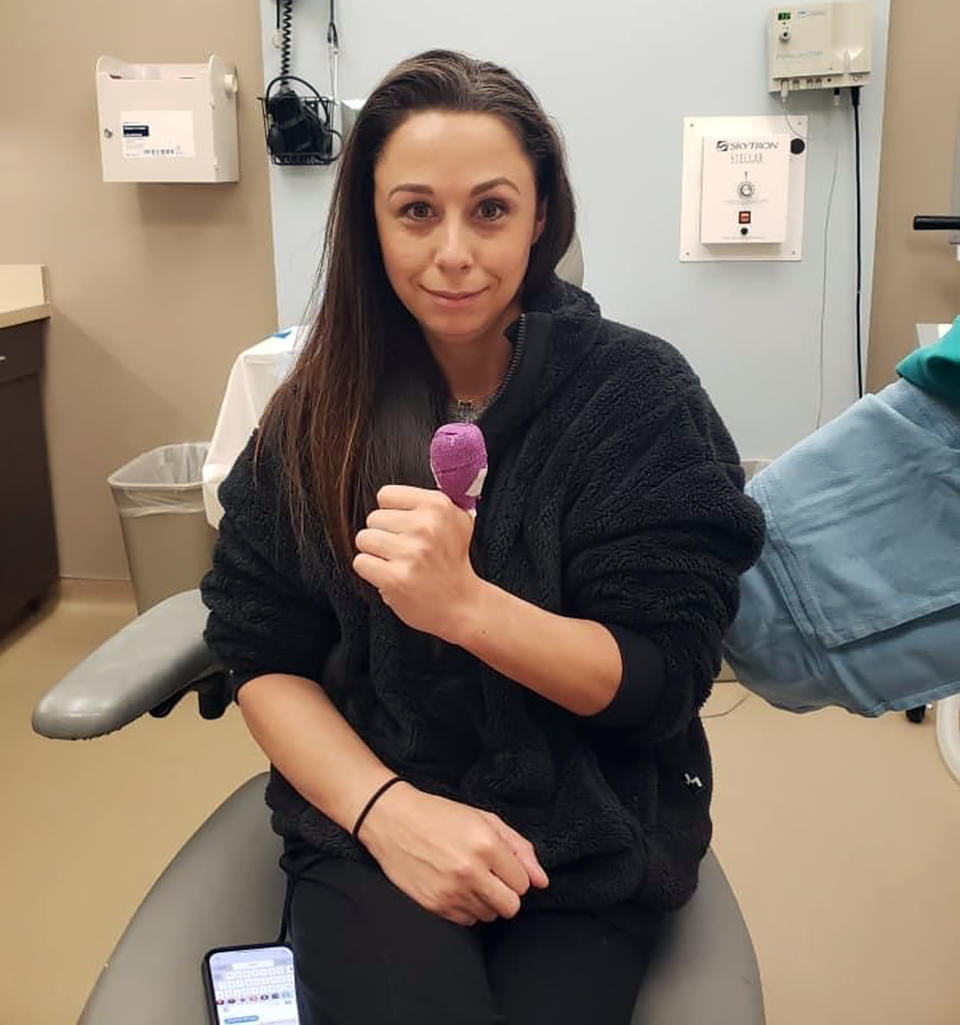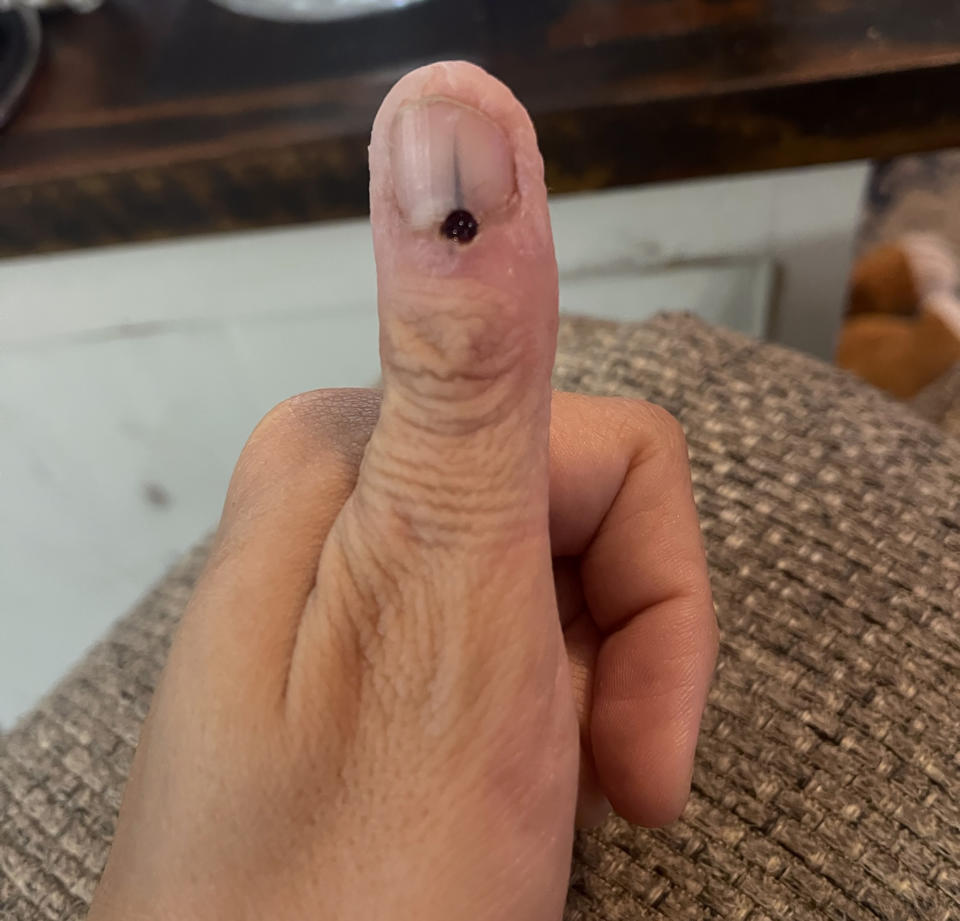She noticed a tiny line under her nail. She had no idea it was a sign of a rare melanoma
This summer, Charmaine Sherlock noticed a thin black line under her nail of her left thumb — what looked like a splinter growing from her cuticle. She thought perhaps she was having an autoimmune reaction. But then she visited a dermatologist for an unrelated rash and learned that the tiny line could be the sign of rare, aggressive melanoma.
“When (nurse practitioner) saw it, she actually gasped audibly,” Sherlock, 34, of Arlington, Texas, tells TODAY.com. “I only went to the doctor because of a rash.”

Sherlock is sharing her story to encourage others to advocate for themselves when they notice changes in their bodies, even if they seem minor.

“Everyone that I have told has never heard of this. Everyone that I’ve told they said if they would have gotten a black line on their nail, they would have never gone to the doctor about it because it didn’t hurt at all,” she says. “It just looks strange.” Black line that changed quickly
After Sherlock first noticed the tiny black line, she Googled it and learned that it could be a sign of cancer or an autoimmune reaction. It was so tiny that she didn’t think it could possibly be the former, but she soon noticed that it was growing. Within a month, it went from barely noticeable at the base of her thumb nail to more than halfway up her nail. Still, she didn’t think the small mark could be as dangerous as subungual melanoma, a rare and aggressive type of skin cancer.
“All of the pictures on Google were horrific. These nails were like falling off. They were black. Most of them, the entire nail was black, and the line was really really thick,” she says.
In comparison, her line looked small.
“Most people develop a line on their nail, and they don’t really think anything of it,” Sherlock says. “I noticed it.”
When she visited the dermatologist for her rash and the nurse saw it, she became concerned. After that appointment, Sherlock began photographing her nail every few days to track any changes. The doctor wanted her to return for a biopsy, in which a hole is punched into the nail to get to the nail matrix, where the nail grows from.
“I was not prepared at all for the painful biopsy because I didn’t research anything. … I thought it was probably nothing, and I just didn’t believe it was melanoma,” she says. “It’s very shocking. I could feel the cauterization.”

She told the staff she was glad she was lying down for the procedure because she might have fainted. After, she asked the doctor what the next steps would be if she had cancer, and he said he'd refer her to a hand surgeon. As she waited two weeks for the results, she began researching nail melanoma. She found a melanoma expert in Dallas and began watching his YouTube videos.
“During that waiting period I was pretty sure that the dermatologist biopsied it incorrectly. But I was like, ‘Well, I’m not a doctor,” she recalls.
The biopsy results returned that she had a lentigo maligna, a mark from sun damage that "eventually ... may develop into melanoma," according to the Mayo Clinic. While the doctors staff treated the results as good news, Sherlock wanted another opinion. She was worried because the line kept growing.
“I was taking pictures every day after the biopsy to track it, and there were some days (that) I could see growth from one day to another,” she explains. “It was growing like crazy.”
“All (I've) ever heard is if you have something on your skin that’s changing … you need to see a dermatologist,” she adds. “(It was) not normal. Things don’t change.”
She scheduled an appointment with a second doctor, who shared pictures of the nail and the biopsy with a pathologist, a type of health care provider who examines body tissue and performs lab tests. That doctor believed the original dermatologist didn't do the biopsy in the proper location or go deep enough for the sample, Sherlock says.
"If they don’t get a deep enough sample in the right place, they’re only seeing a tiny piece of the tissue," Sherlock recalls the doctor telling her.

Ahead of the second biopsy, Sherlock felt “petrified” given how terrible the first was, but the new doctor assured her that she’d have a nerve block for the pain. When the results of the second biopsy returned, Sherlock learned that she had a subungual melanoma.
“I didn’t cry for two weeks probably. I was in denial,” she says. “I just couldn’t even hardly believe it. It’s so rare! (When) I went to have my second biopsy, they were telling me that (I) need to fight for my thumb because everyone is going to want to amputate it.”
Subungual melanoma
Subungual melanoma, or nail cancer, is a rare form of skin cancer. According to the National Library of Medicine, nail melanoma make up about 0.7% to 3.5% of “all malignant melanomas” in the world.
“It’s a pretty rare subtype. However because of that it could be missed and could go on for years without being recognized,” Dr. Adam Friedman, interim chair of dermatology at George Washington School of Medicine and Health Science, told TODAY.com in April 2022. “It can certainly be aggressive if not caught. That’s the rule of all melanomas.”
Subungual melanomas look like a brown, tan or black line on the nail. But they can be hard to detect and diagnose because numerous things can cause nail discoloration, such as fungal infections, bruises, moles and nail injuries, all of which are much more common than subungual melanomas. (Moles under the nail should also be observed for changes, just like anywhere else on the body.)
“It gets a little trickier because how do you definite it? Is it just a band from a healthy mole or is it a band from melanoma,” Friedman said. “Is the band getting wider and darker over time? Is there any injury to the nail itself?”

Treatment and recovery
In early November, Sherlock had Mohs surgery on her thumb, which removed her nail. Tests performed afterward revealed that doctors would have to remove even more of her thumb.
“I had two rounds, which was disappointing. I really only mentally prepared myself for one,” Sherlock says. “They went all the way down to the bone. … I was essentially left with a thumbprint and they wrapped it up.”
They put a temporary material over her thumb so her skin and blood vessels could great, which will help her future skin graft be more successful. (A skin graft is when skin is transplanted from one part of the body to another.)
The surgery might have damaged some of her tendons, which could lead to permanent mobility issues.
“We don’t know that for sure because my thumb is very swollen,” she says. “I can’t bend it. It just stays in an upright position now.”
Sherlock still feels surprised by the diagnosis. She has no family history of melanoma or other skin cancer. She admits she primarily started taking pictures of her nail after the first biopsy because she was grossed out by how it looked and some family members were curious to see. In one picture in particular, she noticed the line had gotten significantly darker than it was on the day of the first biopsy.
“I thought, you know what, I’m going to track this thing,” she says.
Her diligence and willingness to ask for a second opinion meant she was treated while her cancer was stage 0. But at times, she still felt scared.
“The fact that I had to go do a second opinion, I was really stressed,” she says. “(I thought) 'Maybe I am overreacting. I’m not a doctor and I’m reading all these things that are above my head.’”
But speaking out has made a difference.
“The melanoma is gone, and that is ultimately the best outcome,” Sherlock says.
This article was originally published on TODAY.com

